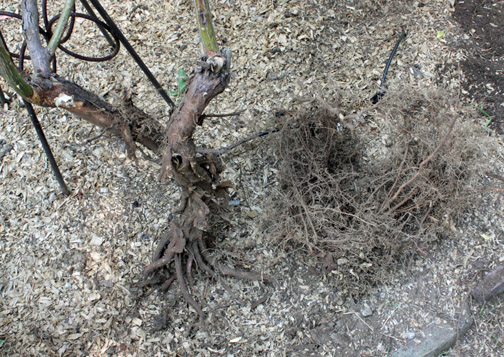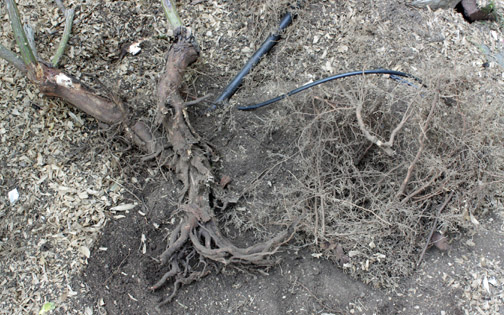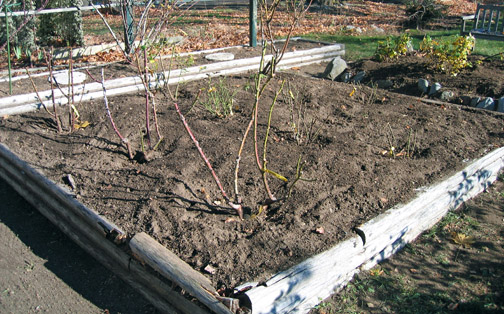
High Crimes and Dirty Deeds
by Mike Chute
Trees and roses are uneasy companions in the landscape. While each adds its own special beauty to its surroundings, trouble brews when these two species come into close contact with one another. Trees have a size advantage and don’t hesitate to use it to purloin all the sunlight, water and nutrients they can from their surroundings. We determined this first hand in our mature rose garden which shares the back of the property with a large majestic maple tree. As this garden grew, we kept an eye on the shadow cast by the tree, being careful to plant roses where they would receive sufficient sunlight. We even had an arborist thin the canopy of the tree several times over the years, hoping to add extra sunlight to the plantings below. This strategy worked for a season or two, but the canopy always filled in taller and fuller than before. Over time the tree fell into a life of crime, pilfering more and more sunshine. The solution was clear. Wait until the garden goes dormant – late October – then remove all the roses in each bed and completely clean out the roots. What I found as I lifted each bush was absolutely appalling! Encircling the shank of every rose, just below the soil line and extending out a foot, was a heavy mat of fine tree roots six inches thick, completely choking the rose’s own roots. (See photo above.) The soil under this suffocating mass was bone dry, parched, nothing I pulled, shoveled, hacked, slashed, sliced, diced, and chopped my way from one side of each bed to the other, filling a 32-gallon barrel twice with tree roots. Once all the roots were rogued out, I amended the soil with lime and a generous helping of aged horse manure. I replanted some of the old roses immediately, leaving space for some novel hardscape to be added in the spring as well as new bushes scheduled to arrive in November. (See photo below of newly planted roses in cleaned out raised bed.) I know that this is only a temporary solution because the tree is a known repeat offender. In a few seasons the tree roots will slither back into the beds, drawn there by the promise of tasty food and drink and I will have to repeat this laborious process. The felonious maple is on probation and more drastic measures may follow. But for now, horticultural harmony has been restored and I can enjoy the shade and autumn color from this leafy brigand as well as the anticipated benefits from two newly reconditioned rose beds. Things could be worse. Copyright © 2011by Mike & Angelina Chute |
 Stolen sunlight wasn’t the only arboreal misconduct. The tree’s roots quietly embezzled water and nutrients meant for roses and all this larceny created a challenging microclimate for the rose garden. I discovered this hard reality several years ago when I found thick tree roots had invaded most of the raised rose beds and I cleaned them out as best I could without tearing the beds apart. But this season the two beds closest to the tree went into a steep decline even though they were well outside the drip line of the tree and had received the same amount of water and nutrients as the rest of the garden. I fully realized the extent of the root problem when my weeder bounced off the soil as I attempted to scratch fertilizer around the base of each plant.
Stolen sunlight wasn’t the only arboreal misconduct. The tree’s roots quietly embezzled water and nutrients meant for roses and all this larceny created a challenging microclimate for the rose garden. I discovered this hard reality several years ago when I found thick tree roots had invaded most of the raised rose beds and I cleaned them out as best I could without tearing the beds apart. But this season the two beds closest to the tree went into a steep decline even though they were well outside the drip line of the tree and had received the same amount of water and nutrients as the rest of the garden. I fully realized the extent of the root problem when my weeder bounced off the soil as I attempted to scratch fertilizer around the base of each plant.  but arid dust despite ample rain and watering. The thieving tree had absorbed all the water and nutrients, allowing very little to trickle down. This explained the malnourished bushes despite the presence of abundant fertilizer and water in the soil. Because these roses were dormant, I was able to shake out the soil from the root ball and tease out all the tree roots. (Picture at right shows mass of tree roots removed from the rose.) I trimmed off any broken or damaged rose roots and then pruned the canes back by half. After that, I placed each rose into a bucket of water to await replanting.
but arid dust despite ample rain and watering. The thieving tree had absorbed all the water and nutrients, allowing very little to trickle down. This explained the malnourished bushes despite the presence of abundant fertilizer and water in the soil. Because these roses were dormant, I was able to shake out the soil from the root ball and tease out all the tree roots. (Picture at right shows mass of tree roots removed from the rose.) I trimmed off any broken or damaged rose roots and then pruned the canes back by half. After that, I placed each rose into a bucket of water to await replanting. 